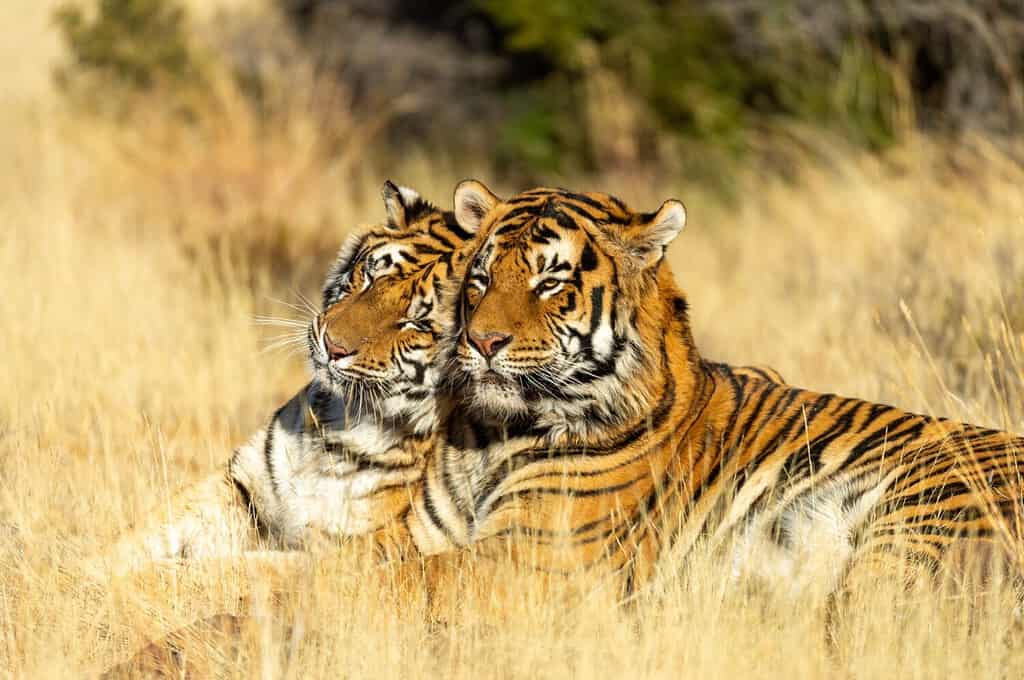Tigers have a lot of ways they communicate with each other. They speak with their tails, body posture, scents, and powerful vocalizations. Every sound a tiger makes has a different purpose, and some calls are capable of sending out more than one message. From low growls to booming roars, these big cats have a wide range of noises to choose from. These amazing cats can even make infrasounds with frequency so low they’re inaudible to human ears.
Are you ready to speak tiger? Then you’re in the right spot. Read on to learn all of the sounds a tiger makes, and why.
Key Points About Tiger Sounds
- Tigers growl, roar, moan, hiss, bark, gasp, and chuff.
- Tigers have a mini-roar known as a click-roar.
- Chuffing is used for courtship, greetings, and comforting young tigers.
- Tiger roars are audible up to 2 miles away.
- Contact calls, sounding like “owh,” are used by tigers to peacefully reclaim territory.
- Tiger cubs start with a high-pitched whine.
- Tiger moans can help guide cubs.
- Chuffing or prusten involves quickly blowing air from their nostrils
- Tigers use infrasound to attract mates and deter rivals.
- Tigers cannot meow or purr due to their laryngeal structure.
- Recordings of tiger vocalizations are helping researchers track populations.
What Sound Do Tigers Make?

A tiger can growl, roar, moan, hiss, bark, gasp, snarl, and chuff.
©Thinker360/iStock / Getty Images Plus via Getty Images
Tigers growl, roar, moan, hiss, bark, gasp, and chuff. They also make “mrr” noises and “arf” sounds. The “mrr” noise can sound a bit like a cow’s moo. Each vocalization communicates a different idea, and some serve more than one purpose. A tiger’s roar helps them communicate when they’re distressed, looking for a mate, or about to fight.
Here’s a list of the many sounds tigers make:
- Growl
- Roar
- Moan
- Hiss
- Bark
- Gasp
- Chuff
- Mrr
- Arf
- High-pitched whine
- Contact call (“owh” sound)
- Click-growl (mini-roar)
- Infrasounds
- Bark
Born blind, deaf, and weighing less than 4 pounds, tiger cubs rely on a high-pitched whine to communicate. As they age the sound becomes a bit deeper, similar to a bleating goat. Soon the little cubs start working their way up to a more mature voice, and eventually a roar.
Contact Call
Purpose of vocalization: Helps tigers to reclaim territory or communicate with others.
Tigers are known for making a contact call. It sounds a bit like, “owh”. The “w” sound gradually increases, so the full call sounds more like “OwwwwWWWWW”. Tigers will make this sound over and over to send their message.
Contact calls are a friendly way of letting another tiger know that a space is occupied. This call has been observed by tiger keepers, especially when watching Sumatran tigers. It’s one of the most common calls these tigers make. It’s the best way for these big cats to peacefully reclaim their territory as they move about through the day.
Bark
Purpose of vocalization: Expresses anger, signaling displeasure or agitation.
An amazing tiger conservation project (Prusten Project), led to the discovery of new tiger sounds. When zookeepers in Tulsa said they had a barking tiger, researchers weren’t sure what they meant. But after arriving on site to make a recording, they were able to capture the “bark” in all its glory. The recording of the tiger bark is a must-hear for all big cat lovers.
Unlike dogs who bark to communicate happiness, tiger barks to communicate anger. They’ll bark if they see an animal they don’t like, are startled, or are just having an off day. Unlike the long drawn-out roar, a tiger’s bark is more like an abrupt snarl.
Moans
Purpose of vocalization: Tiger moans can guide cubs, ease anxiety during mating, and express discomfort.
Tiger moans can be so loud that they’re sometimes mistaken for roars. It’s not uncommon for a moan to sound like a combination of a whine and contact call, with a little bit of hiss thrown in. The volume and intensity of the moan depend on what the tiger wants to say. A tigress will give out a simple moan to get her cubs to follow her. This sounds a lot different than the moan a tiger makes when it’s anxious. Males will also moan during the mating season to help females relax.
Chuff or Prusteen
Purpose of vocalization: Chuffing is a friendly vocalization used for courtship, greetings, or to comfort young tigers.
Tigers don’t purr, but they do chuff. Jaguars and clouded leopards also share this vocal ability. Chuffs happen during courtship or when a tiger just wants to say hello to another tiger they recognize. They’re also a good way for a tigress to comfort her young.
Chuffing, sometimes called prusten, happens when a tiger blows air out of its nostrils. The air comes in short, loud bursts creating the low-intensity sound. After producing a breathy snort the tiger usually bobs their head around a bit. The noise you hear is possible because the tiger keeps their mouth completely shut the whole time. It’s similar to the lip trills a human can make by blowing air out of their mouth to make their lips flap. For chuffs, the tigers make their nostrils flap.
Mini Roar or Click Growl
Purpose of vocalization: This mini-roar is often heard during conflicts over territory or food.
Tigers also have a mini-roar known as a click-growl. This sound is common if tigers are fighting over a meal or territory. The click-growl happens when the tiger opens their mouth, and pushes air over their vocal cords and past the larynx. The open-mouth posture helps produce the sound, while also showing off their intimidating canines.
Snarl
Purpose of vocalization: Intimidate any threats, and keep adult males away from cubs.
If a tiger feels threatened it’ll let out a nasty snarl. This intimidating sound helps scare off trouble, which sometimes comes from other tigers. It’s not uncommon for a tigress to snarl when protecting her cubs from adult males. This vocalization is the warning cry that comes before an all-out roar.
Roar
Purpose of vocalization: Roaring can signify distress, mark territory, attract mates during mating season, or warn rivals.
Tiger roars can be heard almost 2 miles away. A booming roar can mean a tiger’s in pain or defending its territory. And during mating season, the long-distance call takes on an entirely new meaning. Males will roar to attract potential mates, and females will roar to show they’re receptive. The more interested a tiger is, the more they’ll roar. In one study a female tiger roared 69 times over 15 minutes.
A tiger’s roar is a lot like the cry of a newborn baby but with a lower-pitched frequency. This discovery came to light when researchers discovered tiger vocal cords are similar to those of a newborn human. Both tigers and babies have gel-like vocal cords that are wiggly and vibrate irregularly to create a rough ear-piercing sound.
How Do Tigers Roar So Loudly?

Tigers and lions are famous for their loud booming roars that can travel long distances.
©Eric Isselee/Shutterstock.com
How do tigers roar so loudly? It’s not just because they have large vocal cords. The volume also comes from the presence of fat in the vocal ligaments, flat-square-shaped vocal folds, and the fact that their cry works similarly to that of a newborn baby.
Large Vocal Cords
Tigers have gigantic vocal cords, or folds, that are about 1 inch tall, 1 inch thick, and 1.5 inches long. Lions also have large vocal cords that help them create terrifyingly loud roars.
Fat
Tigers roar loudly because they have fat cushioning their vocal cords. The fat rests deep within the vocal fold ligament, which gives the folds their shape. The fat may also help repair the vocal cords if they get stressed out.
Flat-Square Shaped Vocal Cords
Unlike many big cats, tiger vocal folds have a special flat-square shape that’s excellent at responding to air. The presence of fat helps create the flattened square shape. When air goes over the vocal cords, they vibrate up and down and side to side.
Tigers Make Sounds Inaudible to Human Ears

Tigers can make low-frequency sounds that are inaudible to human ears.
©Voyagerix/Shutterstock.com
So far we’ve been talking about tiger sounds that you can hear. But what about the noises they make that are inaudible to human ears?
Rhinos, whales, hippos, and tigers survive with the help of infrasound. These noises have sound waves that are lower than 20 Hz. This makes them silent to human ears who usually hear at frequencies between 20 Hz to 20,000 Hz.
Even though you can’t hear these sounds, you can still feel them. Infrasounds are so strong they can pass through large objects. Plus, their low pitch gives them the ability to travel long distances. The lower the frequency of the sound, the further it travels.
Infrasounds Scare off Rivals
Tigers use powerful infrared sounds to attract mates, as well as scare off the competition. These sounds are one of the best tools this big cat has for protecting its large hunting grounds. It’s not uncommon for a single tiger to have a 60-mile radius for their hunting territory.
Can Tigers Meow?

Tigers can’t meow because of a ligament that attaches to their larynx.
©manfredstutz/Shutterstock.com
No, tigers cannot meow. However, they do make an adorable, “mrf”, or “moo” like sound which some believe is their form of meowing.
Big cats, like tigers and lions, are excellent at roaring. But when it comes to making delicate “meows” their vocal cords can’t accommodate. This is because these big cats have an extra ligament on their larynx. This ligament helps them create loud low-pitch frequencies while inhibiting other sounds.
Why Can’t Tigers Purr?

Even when they’re happy and relaxed, tigers are incapable of purring.
©Amani A/Shutterstock.com
You’ll never hear a tiger purr, but it’s not because they’re never happy. They’re just not able to make this famous cat sound. The same tough cartilage that helps them roar keeps them from meowing.
Purring is possible because of the delicate bones that run from the base of a cat’s skull to their tongue. When the cat’s voice box vibrates, the tiny bones resonate to create a purring sound. Tigers don’t have these delicate bones connecting to their larynx, or voice box. Instead, they have tough cartilage.
Prusten Project: Saving Tigers With Their Own Sounds

The Prusten Project is using recordings of tiger vocalizations to help track their populations.
©sarayut_sy/Shutterstock.com
Tigers are an endangered species, with less than 6,000 believed to be roaming the planet. Now, it looks like the voices of these big cats might be the very thing that keeps them from going extinct.
The Prusten Project, created by Courtney Dunn, involves collecting recordings of tiger sounds from zookeepers. Researchers can then use these recordings to build a computer program that identifies tigers based on their sounds. This tool will be helpful for accurately monitoring tiger populations, and it’s only possible because tigers make such unique calls.
The photo featured at the top of this post is © Thinker360/iStock / Getty Images Plus via Getty Images
Thank you for reading! Have some feedback for us? Contact the AZ Animals editorial team.







